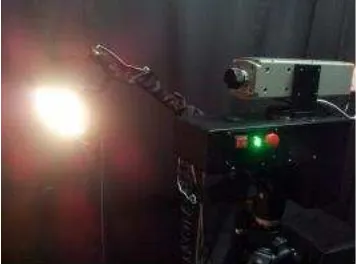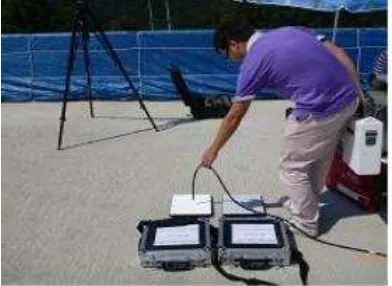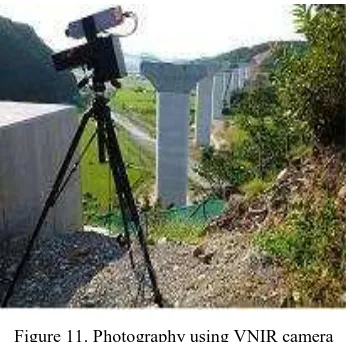ANALYSIS OF CONCRETE REFLECTANCE CHARACTERISTICS USING
SPECTROMETER AND VNIR HYPERSPECTRAL CAMERA
Jin-Duk Lee a *, Bon A. Dewitt b, Sung-Soon Lee c, Kon-Joon Bhang a, Jung-Bo Sim a
a School of Civil and Environmental Engineering, Kumoh National Institute of Technology, 730-701 Gumi, Korea - jdlee@kumoh.ac.kr, bhang.1@kumoh.ac.kr, mungmungmungv@hanmail.net
b School of Forest Resources and Conservation, University of Florida, FL32611, Gainesville, United States - bon@ufl.edu
c
Korea Institute of Geoscience and Mineral Resources, 305-350 Daejeon, Korea - gisyi@kigam.re.kr
Commission VII, WG VII/3
KEY WORDS: Hyperspectral Images, Spectrometer, VNIR Hyperspectral Camera, Reflectance Spectra, Concrete Structures
ABSTRACT:
The purpose of this research is to extract spectral reflectance characteristics of concretes through basic experiment on concrete specimens and site experiment on actual concrete structures using a field portable spectrometer and a VNIR hyperspectral sensor. A spectrometer (GER-3700) and a VNIR hyperspectral camera (AisaEagle VNIR Hyperspectral Camera) were utilized for extracting spectral characteristics of concrete specimens and actual concrete structures. General concretes show similar pattern with correlation more than 80%, while super high strength concrete shows very different aspect from general concretes.
The GER-3700 spectrometer and the VNIR camera were applied to extracting spectral characteristics of the actual concrete structures such as a bridge slab and pier in road construction site. We also made certain in not only interior experiment on concrete specimens but also site experiment on actual concrete structures that both the spectrometer and the VNIR camera vary in spectral reflectance depending on concrete strength. Afterwards if the studies on hyperspectral characteristics of worn-out concretes, concrete aggregate condition diversity, super high-strength concretes are performed in depth, it is helpful in stability evaluation and maintenance management of concrete-based structures or facilities using airborne or satellite hyperspectral images for a wide area.
*Jin-Duk Lee, School of Civil and Environmental Engineering, Kumoh National Institute of Technology, jdlee@kumoh.ac.kr
1. INTRODUCTION
:
Recently necessity of system development and improvement related to concrete characteristics is recognized largely with regulation establishment for maintenance of concrete facilities in construction markets. Concrete structures has been continuously increased with industrial development and along with this, structural monitoring techniques has been advanced. We set to work on this research based on the idea that hyperspectral remote sensing also might be utilized for monitoring concrete structures. If spectral characteristics according to concrete conditions can be understood, hyperspectral imagery may be applied as a useful instrument for surveying the current state for a number of concrete structures or facilities distributed in an urban area.
Hyperspectral imagery has been used to detect and map a wide variety of materials having characteristic of reflectance spectra. For example, hyperspectral images have been used by geologists for mineral mapping (Clark et al., 1995) and to detect soil properties including moisture, organic content, and salinity (Ben-Dor, 2001). Vegetation scientists have successfully used hyperspectral imagery to identify vegetation species(Clark et al., 1995), study plant canopy chemistry, and detect vegetation stress. Military personnel have used hyperspectral imagery to detect military vehicles under partial vegetation canopy, and many other military target detection objectives (Peg Shippert,
2003). Lately Yavari et al.(2010) evaluated quality changes of heated oils based on visible/near infrared spectral analysis using a spectrometer. The use of reflectance spectroscopy across the visible near- and short-infrared spectral region (400 to 2500 nm) was suggested as a tool to assess the status of concrete in situ(Anna Brook and Eyal Ben-Dor, 2011).
The purpose of this research is to extract spectral reflectance characteristics of concretes through basic experiment and on-site experiment using a spectrometer and a VNIR hyperspectral sensor. In this research, a spectrometer (GER-3700) and a VNIR hyperspectral camera (AisaEagle VNIR Hyperspectral Sensor) were utilized for extracting spectral characteristics of concrete specimens and actual concrete structures.
2. BASIC EXPERIMENT FOR EXTRACTING
HYPRSPECTRAL CHARACTERISTICS OF CONCRETES
2.1 Extracting Spectral Characteristics of Concrete Specimens Using Spectrometer
For understanding characteristics of concretes, the concrete specimens for compressive strength test were produced not only with different water/cement ratio but also with different concrete curing time. The design compressive strengthes of eight specimens of general concrete were 15MPa(22), International Archives of the Photogrammetry, Remote Sensing and Spatial Information Sciences, Volume XXXIX-B7, 2012
XXII ISPRS Congress, 25 August – 01 September 2012, Melbourne, Australia
15MPa(24), 21MPa(27), 21MPa(28), 24MPa(37), 24MPa(37), 27MPa(38), and 27MPa(37) at 27 days material age which were planned by different water/cement ratio(The figures in parentheses refer to actual strengthes).
A field portable spectrometer, GER-3700 had 350nm to 2500nm in spectral range and 704 in band number. However it's demerit is to measure only an object at once because it can acquire just point data.
Figure 1. Specrometer GER-3700
We measured a white reflectance pannel of 99% spectral reflectance rate with GER-3700 and considered the measurement as reference data and then acquired spectral information by measuring concrete specimens respectively.
Figure 2. Reference data obtained by measuring white reflectance panel
Figure 3. The example of reflectance curve of concrete specimens according to strength depending on different w/c
Normalization should be performed prior to specimen analysis and then it is needed to compare with spectral reflectance of airborne or satellite remote sensing data. General concretes specimens with different strength and a super high-strength specimen were measured by the spectrometer. As a result of measuring base planes of the specimens, spectral characteristics
were shown almost similarly on the whole, however they appeared different aspect according to the strength in the range of 1950nm to 2350nm
Figure 4. Spectral reflectance of concretes according to compressive strength extracted by spectrometer
Eight general strength concretes show similar pattern with correlation more than 80%, while a super high strength concrete which is expressed with the very last legend shows very different aspect with general concretes.
2.2 Extraction of the spectral characteristics from VNIR hyperspectral camera
AisaEagle VNIR hyperspectral camera is 400~970nm in spectral range and at maximum 1040 in band number. Spectral data collected by a hyperspectral camera as well as a spectrometer can be utilized as terrestrial truth data for extracting accurate spectral reflectance and furthermore analyzing airborne or satellite hyperspectral remote images. Spectrometer data as well as VNIR hyperspectral camera images are helpful in maintaining concrete-based structures, buildings, highways and so forth by means of airborne- or satellite-based hyperspectral imagery. In addition, hyperspectral data for a variety of concrete objects need to be saved in the form of spectral library for rapid and appropriate decision-making related to maintenance of concrete structures or facilities.
In this research, we photographed all of 99%, 75% and 2% reflectance pannels and the concrete specimens with different strengths at 27 days material age to be included in only an image using the VNIR camera because target objects are taken together with a reflectance pannels for getting accurate reference values.
Figure 5. VNIR hyperspectral camera International Archives of the Photogrammetry, Remote Sensing and Spatial Information Sciences, Volume XXXIX-B7, 2012
XXII ISPRS Congress, 25 August – 01 September 2012, Melbourne, Australia
Figure 6. VNIR sensor image
Figure 7. The full screen of VNIR program
Spectral information was able to be extracted by pixel from photographed imagery by using ENVI software. Spectral information, which was shown on the spectral profile window as shown in Figure 8, was saved in ASCII file form and then processed in Excel with reference to the reflectance of 99% white pannel like the case of GER-3700
Figure 8. Spectral Profile
Figure 9. Spectral characteristics of reflectance panels and concretes extracted by VNIR camera
Figure 9 shows reflectance according to wavelength for four different specimens and four different reflectance pannels. Reflectance rates were computed by dividing into the value of 99% reflectance pannel. In interior experiment, the results of the spectrometer showed more consistent reflectance curve in SWIR range than VNIR range and appeared high reliability compared with those of the VNIR hyperspectral camera.
3. EXPERIMENT ON ACTUAL CONCRETE
STRUCTURES
The GER-3700 spectrometer and the VNIR camera were applied to the actual concrete structures such as a bridge slab and pier in a road construction site. The experimments were conducted for the upper side of pier of Daejongchun Bridge and the decks surface of Yangbuk Bridge.
The result values of GER-3700 shows high absorption at 1950nm against those of interior experiment on concrete specimens. However it can't be considered as an error because all of spectral data which were collected in the construction site appear high absorption or reflectance in 1950nm. And results in VNIR (visible and near infrared) wavelength range show almost similar pattern with those of interior experiment.
Figure 10. Data Collection using GER-3700 on Yangbuk Bridge
International Archives of the Photogrammetry, Remote Sensing and Spatial Information Sciences, Volume XXXIX-B7, 2012 XXII ISPRS Congress, 25 August – 01 September 2012, Melbourne, Australia
Figure 11. Photography using VNIR camera on Daejongchun Bridge
We also made certain in not only interior experiment on concrete specimens but also site experiment on actual concrete structures that both a spectrometer and a VNIR camera show the difference in spectral characteristics according to concrete strength. But two types of sensors showed some difference in spectral reflectance in spite of the same target.
Figure 12. Reflectance spectra of two concrete structures measured by GER-3700 and VNIR camera
4. CONCLUSION
Through interior experiment on specimens and site experiment on actual structures, spectral characteristics of concretes were analyzed in accordiance to concrete strength using two types of terrestrial hyperspectral sensors.
Field portable spectrometer data as well as VNIR hyperspectral images are very useful as reference data in analyzing for maintenance of concrete-based structures, buildings, highways using airborne or satellite hyperspectral images. In addition, hyperspectral data for a variety of concrete objects need to be saved in the form of spectral library for rapid and appropriate decision-making related to maintenance of concrete structures or facilities.
Afterwards if the studies on hyperspectral characteristics of worn-out concretes, concrete aggregate condition diversity, super high-strength concretes are performed in depth, it is helpful in stability evaluation and maintenance of concrete-based structures or facilities using airborne or satellite hyperspectral images for an wide area.
ACKNOWLEDGEMENTS
This research was supported by Basic Science Research Program through the National Research Foundation of Korea(NRF) funded by the Ministry of Education, Science and Technology( grant number : 2012006866).
REFERENCES
1. Alireza Ashkmehr Yavari, M. Hamedi and S. Haghbin, 2010. Investigation of frying oil quality using VIS/NIR hyperspectral Analysis, Journal of the American Oil Chemists’ Society, 86(10), pp. 941-947.
2. Ben-Dor, E., Patin, K., Banin, A. and Karnieli, A.,2001. Mapping of several soil properties using DAIS-7915 hyperspectral scanner data. A case study over clayey soils in Israel. International Journal of Remote Sensing.
3. Clark, R. N., and Swayze, G. A., 1995. Mapping minerals, P.S., 2001. The performance of the satellite-borne HYPERION hyperspectral VNIR-SWIR imaging system of mineral mapping at mount Fitton, South Australia., IGARRS.
5. Fung, T., Ma, F.Y. and Siu, W.L.,1998. Hyperspectral data analysis for subtropical tree species recognition, Geoscience and Remote Sensing Symposium Proceedings, IGARSS '98. IEEE International, Vol.3, pp.1298-1300.
6. Hyun Gee Jo, Dae Sung Kim, Ki Yun Yu, Yong Il Kim, 2006. A study on the hyperspectral image classification with the iterative self-organizing unsupervised spectral angle classification, Korean Journal of Remote Sensing, 22(2), pp. 111-121.
7. Peg Shippert, 2003. Introduction to hyperspectral image analysis, Online Journal of Space Communication, http://spacejournal.ohio.edu/pdf/shippert.pdf. (Jan. 2012). 8. Sun-Hwa Kim, Kyu-Sung Lee, Jung-Rim Ma, Min-Jung Kook, 2005. Current status of hyperspectral remote sensing: Principle, Data Processing Techniques and Application, Korean Journal of Remote Sensing, 21(4), pp. 341-369.
9. Anna Brook and Eyal Ben-Dor, 2011. Reflectance spectroscopy as a tool to assess the quality of concrete in situ, Journal of Civil Engineering and Construction Technology, 2(8), pp. 169-188.
International Archives of the Photogrammetry, Remote Sensing and Spatial Information Sciences, Volume XXXIX-B7, 2012 XXII ISPRS Congress, 25 August – 01 September 2012, Melbourne, Australia


